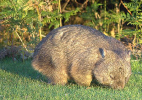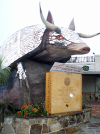Navigation
Install the app
How to install the app on iOS
Follow along with the video below to see how to install our site as a web app on your home screen.
Note: This feature may not be available in some browsers.
More options
You are using an out of date browser. It may not display this or other websites correctly.
You should upgrade or use an alternative browser.
You should upgrade or use an alternative browser.
I've never seen anything like this before.
- Thread Starter adjusterjack
- Start date
army judge
Super Moderator
I spent almost three years living and working for Deloitte & Touché in Australia, 1996 until late 1998.
I enjoyed my work and the citizenry of Oz, they liked Americans and were very kind to me. However, their marsupials, wombat, and Emus could sometimes be very annoying.
One summer day our little group were eating lunch in a local park in the outskirts of Canberra. A hungry Emu approached our table, and eventually stole a loaf of bread and platter of sandwiches.
I think I would much rather share my al fresco lunch with an Emu than the American northeastern yellow jackets. Nasty, aggressive, stingy and violently persistent. shudder... there is no escape as they will follow you. again, shudder.I spent almost three years living and working for Deloitte & Touché in Australia, 1996 until late 1998.
I enjoyed my work and the citizenry of Oz, they liked Americans and were very kind to me. However, their marsupials, wombat, and Emus could sometimes be very annoying.
One summer day our little group were eating lunch in a local park in the outskirts of Canberra. A hungry Emu approached our table, and eventually stole a loaf of bread and platter of sandwiches.
army judge
Super Moderator
I think I would much rather share my al fresco lunch with an Emu than the American northeastern yellow jackets. Nasty, aggressive, stingy and violently persistent. shudder... there is no escape as they will follow you. again, shudder.
True, they're very aggressive.
It was three or four summers ago, I noticed a hive loaded with angry, aggressive African bees.
Called our pest control guy, but he couldn't respond until two days later.
I use bleach for many purposes. I loaded my insecticide lawn hose sprayer with 4 parts bleach and 1 part water. The canister held about 1/2 gallon. Loaded for bees, I returned to about 10 feet away from their hive. Pointed the hose at their hive, and things began to pop. Bees were held off by the solution, started falling immediately upon contact. I was unharmed. The bees lost that day.
Pest control guy and I had a great laugh over it. He said, "You could have been killed." I laughed, that's what I heard in Nam. I spent five years in Nam, returned to the US without receiving the Purple Heart.
If the VC, Chinese Army, and their NoKo pals, along with a few Russkies couldn't take me out, crazed, angry bees couldn't either!
adjusterjack
Super Moderator
I use bleach for many purposes. I loaded my insecticide lawn hose sprayer with 4 parts bleach and 1 part water. The canister held about 1/2 gallon. Loaded for bees, I returned to about 10 feet away from their hive. Pointed the hose at their hive, and things began to pop. Bees were held off by the solution, started falling immediately upon contact. I was unharmed. The bees lost that day.
Ah, the plot for a popular B(ee) Movie.
Redemptionman
Well-Known Member
There are so many things in Australia that can kill you. From poisonous snakes to crazy spiders and insects. Oz is one of the last regimes of the old world when America was 2 or 3 continents only. Kangaroos and Tazzy Devils can and do tear people up.
army judge
Super Moderator
Kangaroos and Tazzy Devils can and do tear people up.
True, but don't dismiss the wombat.
Wombats, wallabys, kangaroos, emus, and armadillos, oh my.
Wombats are tank like critters.
Avoid hitting one, because of their natural body armour, your auto undercarriage could be destroyed.

Wombats can only be found in Australia - the land of dingoes, wallabies, and Tasmanian devils. They look like small, cuddly bears - terrestrial koalas, happy to burrow for roots rather than climb for leaves. The young are cute and playful, making wombats popular attractions at Australian zoos. Wombats move slowly and feed at night. And that's why they show up in math problems.
"Cars arrive along a stretch of road according to a Poisson random process," read my student probability textbook. "What's the chance a crossing wombat arrives safely on the other side?"

Of Wombats and Armadillos
by Andy Boyd Today, why did the wombat cross the road? The University of Houston presents this series about the machines that make our civilization run, and the people whose ingenuity created them.
When I became a professor, I held to the tradition of my alma mater by entertaining students with stories about wombats crossing roads. But my stories didn't prove to be that entertaining. That is, until a student offered a suggestion. "This is Texas," he said. "We don't have wombats. But we do have armadillos." I changed the story line. And from then on the students never failed to laugh.
I'd seen armadillos, but set out to learn more about them and what, if anything, they have in common with wombats. Armadillos most definitely aren't cuddly. They have hard outer shells made of detached plates. It makes them look a lot like medieval knights in armor. Twenty species of armadillo are found in different parts of the Americas.
The delicate pink fairy armadillo is the smallest, at about five inches in length. One species, the Brazilian three-banded armadillo, rolls itself into a ball when threatened. That's not true of the nine-banded armadillo found in Texas and throughout the southern United States.
But while they're not cuddly, armadillos are likable. They have a soft, furry underside and a gentle demeanor, inspiring some people to keep them as house pets. They're related to anteaters, and ask nothing more than bugs and a little grass for food. Armadillos are so likable, Texas designated them the state's official small mammal. (Large mammal bragging rights not surprisingly went to the longhorn.)

A two story Texas armadillo as imagined with long horns.
Redemptionman
Well-Known Member
True, but don't dismiss the wombat.
Wombats, wallabys, kangaroos, emus, and armadillos, oh my.
Wombats are tank like critters.
Avoid hitting one, because of their natural body armour, your auto undercarriage could be destroyed.
View attachment 5403
Wombats can only be found in Australia - the land of dingoes, wallabies, and Tasmanian devils. They look like small, cuddly bears - terrestrial koalas, happy to burrow for roots rather than climb for leaves. The young are cute and playful, making wombats popular attractions at Australian zoos. Wombats move slowly and feed at night. And that's why they show up in math problems.
"Cars arrive along a stretch of road according to a Poisson random process," read my student probability textbook. "What's the chance a crossing wombat arrives safely on the other side?"

Of Wombats and Armadillos
by Andy Boyd Today, why did the wombat cross the road? The University of Houston presents this series about the machines that make our civilization run, and the people whose ingenuity created them.engines.egr.uh.edu
When I became a professor, I held to the tradition of my alma mater by entertaining students with stories about wombats crossing roads. But my stories didn't prove to be that entertaining. That is, until a student offered a suggestion. "This is Texas," he said. "We don't have wombats. But we do have armadillos." I changed the story line. And from then on the students never failed to laugh.
I'd seen armadillos, but set out to learn more about them and what, if anything, they have in common with wombats. Armadillos most definitely aren't cuddly. They have hard outer shells made of detached plates. It makes them look a lot like medieval knights in armor. Twenty species of armadillo are found in different parts of the Americas.
The delicate pink fairy armadillo is the smallest, at about five inches in length. One species, the Brazilian three-banded armadillo, rolls itself into a ball when threatened. That's not true of the nine-banded armadillo found in Texas and throughout the southern United States.
But while they're not cuddly, armadillos are likable. They have a soft, furry underside and a gentle demeanor, inspiring some people to keep them as house pets. They're related to anteaters, and ask nothing more than bugs and a little grass for food. Armadillos are so likable, Texas designated them the state's official small mammal. (Large mammal bragging rights not surprisingly went to the longhorn.)
View attachment 5404
A two story Texas armadillo as imagined with long horns.
Armadillos are fast little suckers and do make noise when they move like carrying armor. I was surprised at how fast they move. You wouldn't think a little thing like that could move so fast but they do.
adjusterjack
Super Moderator
"Cars arrive along a stretch of road according to a Poisson random process," read my student probability textbook. "What's the chance a crossing wombat arrives safely on the other side?"
Which begs the question:
Why did the Wombat cross the road?
army judge
Super Moderator
Why did the Wombat cross the road?
Assist, as in Auto-generated by SQUIGGY, AI BOT. DERIVED by AI sources. May contain some inaccuracies and/or lies!
AI SAYS: The phrase "Why did the wombat cross the road?" is often used humorously to engage students in discussions about probability and road safety, particularly in relation to the dangers posed by vehicles.
Wombats, like many animals, face risks when crossing roads, which can lead to serious accidents.
army judge
Super Moderator
There are so many things in Australia that can kill you. From poisonous snakes to crazy spiders and insects.
True, my friend, but we have many life forms capable of killing you right here in North America, ie... crazed, escaped, deranged prison inmates, dope fiends, alcoholics, pedophiles, perverts, mental incompetents, psychologically disturbed individuals, sexually maladjusted freaks, creepy, mentally disturbed life forms, critters that prowl the darkest shadows/crevices, and iseologigically disturbed, terrorists; along with their "kin" anti-semetic vermin.
Redemptionman
Well-Known Member
True, my friend, but we have many life forms capable of killing you right here in North America, ie... crazed, escaped, deranged prison inmates, dope fiends, alcoholics, pedophiles, perverts, mental incompetents, psychologically disturbed individuals, sexually maladjusted freaks, creepy, mentally disturbed life forms, critters that prowl the darkest shadows/crevices, and iseologigically disturbed, terrorists; along with their "kin" anti-semetic vermin.
True but I keep a 357 SAS SIG around for those situations since I have a CCW permit. I can hit a quarter at 50 yards and ain't skerd. However, lots of criminals running around, and not too many people want to get crazy against a full sized pick up. They know most people driving around in these type trucks can protect themselves. I mean FAFO happens a lot around here.
army judge
Super Moderator
True but I keep a 357 SAS SIG around for those situations since I have a CCW permit. I can hit a quarter at 50 yards and ain't skerd. However, lots of criminals running around, and not too many people want to get crazy against a full sized pick up. They know most people driving around in these type trucks can protect themselves. I mean FAFO happens a lot around here.
Texas is a "constitutional carry" state. You can obtain a CCW License, but why bother?
Constitutionally carrying a concealed (or openly carrying) a revolver/pistol costs nothing, whereas a CCW costs me time and money to obtain.
You can also carry a long gun, should you desire, and no other licensing is required.
Texas has evolved over time, overcoming some deleterious actions/decisions to allow citizens to fully exercise their freedoms.
Redemptionman
Well-Known Member
Texas is a "constitutional carry" state. You can obtain a CCW License, but why bother?
Constitutionally carrying a concealed (or openly carrying) a revolver/pistol costs nothing, whereas a CCW costs me time and money to obtain.
You can also carry a long gun, should you desire, and no other licensing is required.
Texas has evolved over time, overcoming some deleterious actions/decisions to allow citizens to fully exercise their freedoms.
CCW do help in situations where you use your constitutional rights to defend your property and people. It can help in defense of frivolous civil cases whereby you are sued from an evil doers family trying to collect money from you for ending the career or life of their beloved one. For example someone robs a store while you are their and they pulled a gun. You fire for you are in fear of your life thus ending the robber. The family of said robber sues you in civil court. I even think California prosecutes homeowners for defending their property in home evasions. Something about a duty to hide and retreat? LOL.
This is wicked adorably clever! <3

 www.livescience.com
www.livescience.com

Australian 'trash parrots' have now developed a local 'drinking tradition'
Wild cockatoos in Western Sydney have learned to drink from water fountains — choosing to drink from them even if they have to queue.
adjusterjack
Super Moderator
Texas is a "constitutional carry" state. You can obtain a CCW License, but why bother?
This may come as a surprise to you but I am not a fan of constitutional carry. AZ also has it. Leaves a lot of untrained people carrying concealed firearms that probably shouldn't be.
There are many advantages to a CCW permit, not the least of which is reciprocity between states for those who want to travel with their concealed firearm where it might otherwise be illegal.
In my state it allows carrying into some places that would otherwise be illegal.
And best of all, it still requires training, at least initially, where one learns firearm laws and gets some range time.
I will keep renewing mine.
I, personally, have no issue with responsible, trained, sane people carrying/owning a gun. I have issues with any nitwit/mentally ill/criminal/violent person being able to walk into a store and walk out armed. No background check or training.This may come as a surprise to you but I am not a fan of constitutional carry. AZ also has it. Leaves a lot of untrained people carrying concealed firearms that probably shouldn't be.
There are many advantages to a CCW permit, not the least of which is reciprocity between states for those who want to travel with their concealed firearm where it might otherwise be illegal.
In my state it allows carrying into some places that would otherwise be illegal.
And best of all, it still requires training, at least initially, where one learns firearm laws and gets some range time.
I will keep renewing mine.
